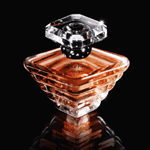
Letters and Comment
Threats on French IP protection for perfumes!

Courtesy of Lancôme
Further to the article In the Courts: Perfumes as Artistic Expression?, here are updates on the situation following two recent decisions in France.
Perfumes have been in the spotlights of French IP practice since a decision by the Paris Penal Court of First Instance dated February 15, 2008. Kenzo Parfums, Lancôme, L’Oreal, Christian Dior Parfums, Yves Saint Laurent Parfums and many other perfume companies had sued several natural persons for trademark infringement for having offered fragrances shown as equivalent to their perfumes for sale. The fragrances were presented with announcements such as “If you like the X perfume, you will like my Y perfume” or “Ask for our list of similar perfumes with well-known perfumes”. The Paris Penal Court decision in February considered that the sole reference made to well-known perfumes was insufficient to demonstrate the material element of trademark infringement.
This decision is in complete contradiction with the French Intellectual Property Code which prohibits unauthorized use, reproduction or affixing of a trademark even with the adjunction of wordings such as “formula, style, system, imitation, genre, method”. The Court position also goes against established case law denying the concordance practice. So we hope this will remain an isolated case and that the appeal lodged by the plaintiffs will succeed.
The protection of perfumes under French copyright is also once again under debate. On June 13, 2006, the French High Court had decided that the creator of a perfume could not receive remuneration under copyright law. Since then, French case law had been ambivalent on whether copyright applies to perfumes. But on July 1, 2008, the French High Court reiterated its past position. The Court ruled that a fragrance only resulted from know-how and was not a creation eligible to copyright protection.
Excluding perfumes from copyright generates high risks in terms of defense policies. Fragrances are also very hard to protect through trademarks, therefore there is increased risk of counterfeiting, especially if, as a result of the above mentioned case law, the concordance practices is permitted. Hopefully, other French legal tools, such as unfair competition and specific protection for well-known trademarks, will remain enforceable.
From Franck Soutoul and Jean-Philippe Bresson, European Trademark Attorneys, INLEX IP Expertise, and reporters for IP TALK, France.
________________
Protecting the NERICA® trademark

Photo: Africa Rice Center (WARDA)
I am writing to comment on one, perhaps minor but possibly important, detail regarding your wonderful article on NERICA®, a product of the West Africa Rice Development Association’s (WARDA) research. I wanted to let you know that the name NERICA® is a registered trademark in the U.S. We are assisting WARDA in several issues dealing with the use of IP management to increase the use of NERICA® rice varieties and to bring quality assurance to the distribution of NERICA® seeds. In this light, I want to ask that you indicate that NERICA® is a registered trademark, as it is important that WARDA protect their trademark so that resource poor farmers will know that they are planting genuine NERICA® seed.
I would be happy to talk with you about additional ongoing research in the Consultative Group on International Agricultural Research (CGIAR) to address the effects of climate change on poor farmers in developing countries.
From Victoria Henson-Apollonio, PhD, Senior Scientist, Project Manager, Central Advisory Service on Intellectual Property, CGIAR System Office Unit, Italy.
Response from the editor:
The WIPO Magazine article did note that "Nerica was registered as a trademark with the USPTO in 2004". As concerns use of the ® symbol the WIPO Magazine article "Trademark Usage: Getting the Basics Right" states: "Use of the ® symbol is not compulsory since it does not provide any legal protection. It is used to alert the public that the mark is registered and therefore may discourage others from illegally using the mark. If the trademark registration notice is used, it should appear with the first and most prominent use of the mark in an advertisement or on a label. It is not necessary to repeat the notice each time the mark is mentioned. (…) When referring to a trademark in printed material, always distinguish the mark from the rest of the text by using either capital letters, bold, color, italics, underline or quotation marks. This will reduce the chance of the mark being seen as a generic term."
__________________
The WIPO Magazine is intended to help broaden public understanding of intellectual property and of WIPO’s work, and is not an official document of WIPO. The designations employed and the presentation of material throughout this publication do not imply the expression of any opinion whatsoever on the part of WIPO concerning the legal status of any country, territory or area or of its authorities, or concerning the delimitation of its frontiers or boundaries. This publication is not intended to reflect the views of the Member States or the WIPO Secretariat. The mention of specific companies or products of manufacturers does not imply that they are endorsed or recommended by WIPO in preference to others of a similar nature that are not mentioned.